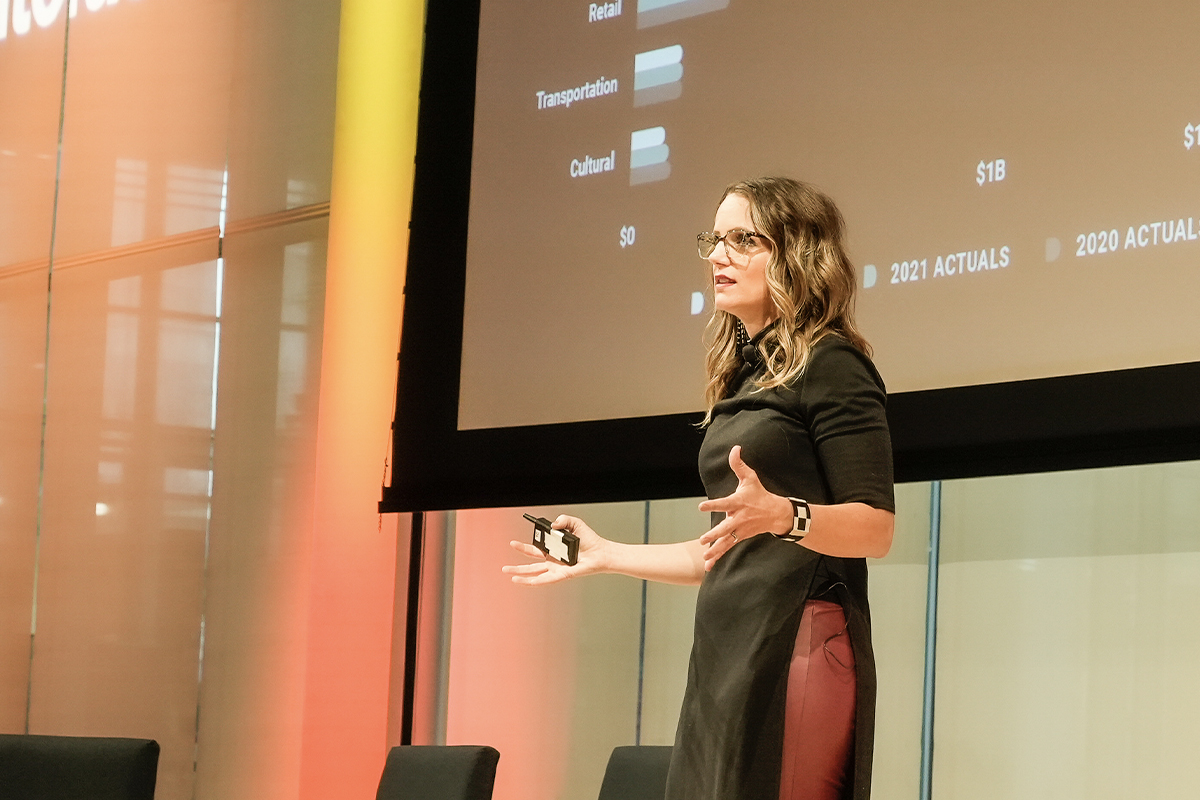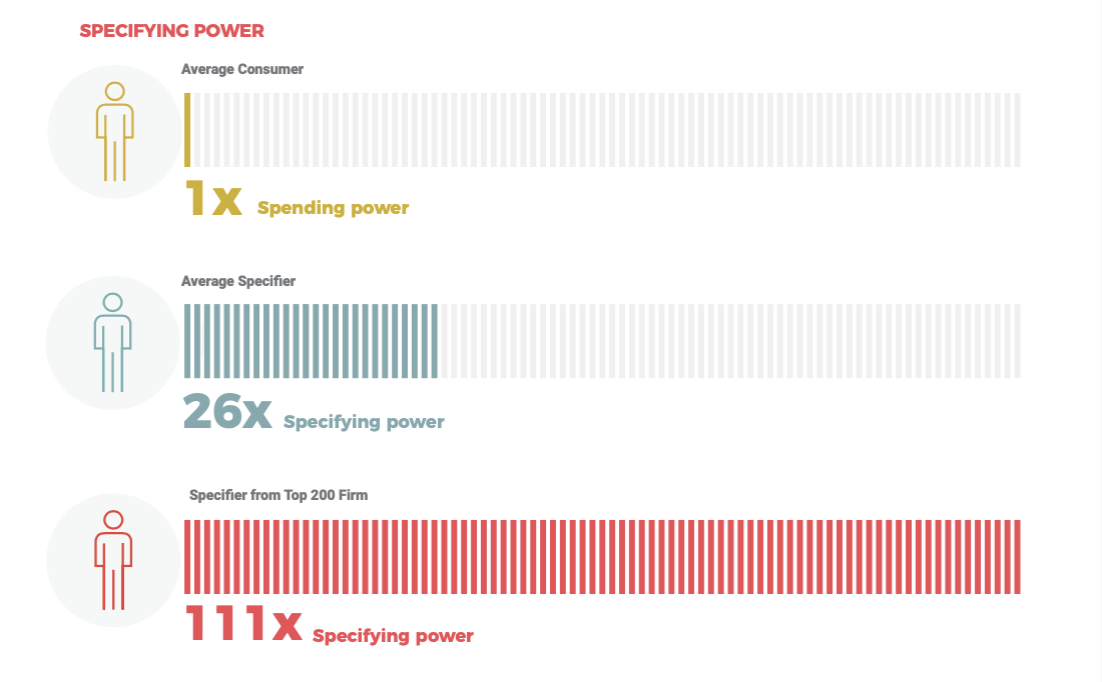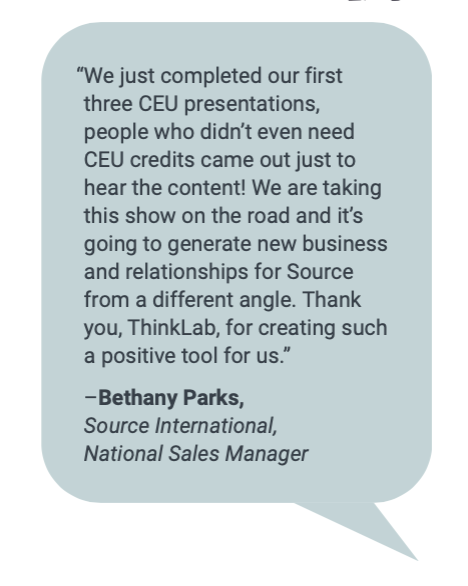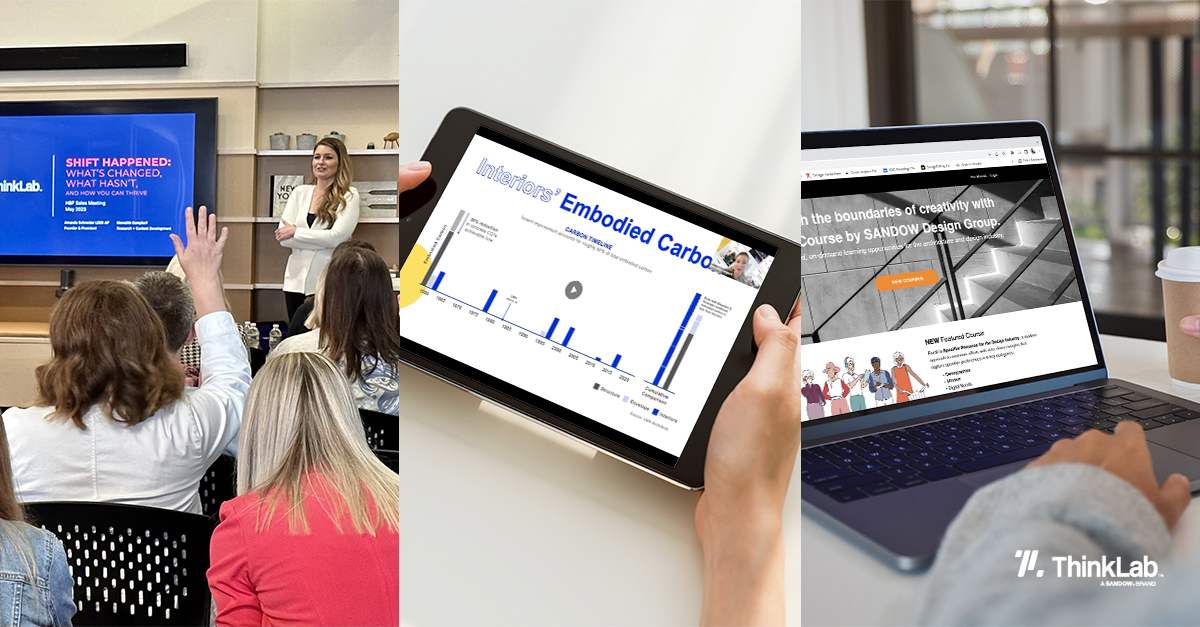How to Create Impactful Interior Design CEUs
The Ultimate Guide for Manufacturers

- Chapter I: Introduction
- Chapter II: TL:DR
- Chapter III: What is a CEU and Who are They for?
- Chapter IV: Why Should Manufacturers Invest in CEU Development?
- Chapter V: The 5 Key Things Every Interior Design CEU Needs
- Chapter IV: How to develop a CEU for Architects and Designers
- Chapter VII: How to Deliver Your CEU
- Chapter VIII How to Promote Your CEU to Architects and Designers
- Chapter IX CEU Resources
Introduction
As a manufacturer, if you are struggling to connect with the architecture and design community we have a recommendation for a fresh way to share the work you believe in with the industry at large.
Cue the commercial interior design CEU.
It’s an ideal way for manufacturers to connect with their A+D audience. And not just connect, but genuinely leave a lasting impression with a captivated audience.
Sure, you could connect at a tradeshow – except whoops, they already lost your business card and forgot what floor your showroom was on. Or you could email them your latest product introduction. Oh wait, it went to junk mail.
A CEU, on the other hand, is an accredited 1-hour presentation on a topic that is super relevant to your intended audience. Add in a great storytelling narrative, compelling visuals, and an amazing presenter to bring it to life and you’ve got their full attention – which means they’re not likely to forget you after that.
A relevant, compelling CEU can help you:
Reinforce your thought-leadership position in the marketplace.
Grow your brand or product awareness on a limited budget
Get your sales reps in the door (especially when selling in this hybrid/virtual era)
But how do you create an effective CEU that is compelling for architects and designers?
In this guide, you’ll learn everything you need to know about developing stand-out CEUs:
- What is a CEU and Who are They for
- Why Should Manufacturers Invest in CEU Development
- The 5 Key Things Every Interior Design CEU needs
- How to Develop a Compelling CEU for Architects and Designers
- How to Deliver Your Interior Design CEU
- How to Promote Your CEU to Architects and Designers
- Interior Design CEU Resources
TL:DR
More of a cliffs notes person? The big idea here is this...
Why Do CEUs Matter to A&D? Keeps them at the top of their design game and in good standing as legally practicing designers and/or with their trade organizations
Why Do CEUs Matter to Manufacturers? 1 hour of undivided customer attention in an era when many manufacturers can’t get 15-minutes of face time, on a topic of interest to architects and designers that reinforces your brand’s thought leadership position, and the ability to raise the questions for which your product becomes their natural solution
Let's get educational (no pun intended) with a basic overview of commercial interior design CEUs.
CEU is an acronym for continuing education unit. CEUs were invented by a national task force commissioned by the Department of Education in 1968 (Source: Thoughtco) and serve as a measure used to assist professionals in maintaining their professional license or standing in various organizations.
CEUs are required in many fields, but the two most relevant to your potential customers are architecture and design. (Source: Wikipedia)
The basic idea is that you don’t want a doctor operating on you who last honed his skill back in 1985. You want someone who is keeping up on the latest and greatest in their profession, and the CEU becomes one way to help A&D professionals do just that. Think of it as lifelong learning in fields that require its professionals to evolve with the times – and architecture and design are two industries that should constantly be evolving, right? Right.
How are credits calculated? Credits are calculated by clock hours.
1 CEU credit = 60 minutes or 1 hour
1.5 CEU= 90 minutes or 1 and one-half clock hours
So when architects and designers attend 1, 1hr presentation, they earn 1 credit, and need to attend a total of 10, 1 hour presentations to get to 10 hours total, the equivalent of 1 CEU. They are also limited to earning 8 credits per day (we call that the procrastinator clause). (Source: IDCEC)
How many CEUs do designers need to attend per year? Well, it varies by state as well as professional organization. Architects need to keep up their requirements through AIA and designers need to renew theirs by CIDQ (The Council for Interior Design Qualification), which is how they keep up their professional NCIDQ certification, as well as any professional organizations they may choose to participate in, three of the most popular being AIA (The American Institute of Architects), ASID (The American Society of Interior Designers) or IIDA (The International Interior Design Association). Other associations who require continuing education include GBCI, IWBI, NKBA, IDC, and many more.
That said, to put the numbers in some perspective AIA requires 18 hours per year, ASID and IIDA require 10 every 2 years, and NCIDQ requires 6 every 2 years.
Who accredits the CEU? CEUs are approved or denied by an independent 3rd party organization, such as IDCEC, AIA, or GBCI.
Not all CEUs are created equal: While any credit is a good one to give, there are extra designations, like IDCEC’s Health, Safety, and Welfare (HSW) that don’t offer more credits but mean that 75% of the CEU topic covers protection of the public and environment that are more helpful, than say, a CEU on color trends. For that reason, some organizations require that a certain portion of each member’s CEU credits have that designation.
For AIA, that number is 12 out of 18 meaning you’re more likely to get an architect to attend your CEU if it contains the HSW designation, and if it doesn’t, the topic better be pretty compelling to them in some other way.
How is a CEU delivered? Traditionally in a 1hour presentation, done in PowerPoint or other presentation software, with sources cited, bibliography included, and interactive participation with the audience allowed but not required. That said, there are other options as well including a panel discussion, on-demand video, or on-demand print as well.
Who can deliver CEUs? Not just anybody with a good idea, computer, and their best intentions. Presentations need to be accredited through various boards, such as IDCEC or AIA in our industry. Presenters (commonly called Instructors) also need to apply, be vetted and approved. Whoever wants to host their CEU needs to register as a provider with their selected organizations (which are most commonly IDCEC and AIA).
Where can Architects and Designers find CEUs they want to attend?
Outside of manufacturer sales reps who often promote CEU topics directly to the A&D firms they service, there are many ways for architects and designers to browse on their own.
The most popular places to browse and register for CEUs are websites of the organizations who help accredit and promote them. IDCEC has a calendar of events and course search (including the ability for A&D to view the top 10 CEUs taken), AEC Daily, AIAU, and more! The best way to start – google. You thought it would be harder, didn’t you?
How long does a CEU last? CEUs have a two-year shelf life, at which point they can be refreshed and resubmitted with an updated bibliography for approval again, if the topic is still relevant to the audience or your brand objectives.
.jpg?width=1200&height=627&name=TL23_Website_Images_PillarPage_1(1).jpg)
2. Why should manufacturers invest in CEU development?
Simply put, architects and designers are busy and CEUs help you reach them.
And they’re busy. Time is money and they’re protective of it. So, it can be hard to get an audience with them without giving them something they want before trying to get something you want from them.
Be a giver. Many firms might not open the doors to see your latest light fixture (sorry), but they will let you in for a CEU.
Investing in CEU development means
Develops trust. If you can give the A&D community your time on a topic they care about, for credits they need, in a way that captures their attention and thirst for industry knowledge, what you’ll get in return is a loyal group of specifiers who turn to you when they need something and want to reach out to someone they respect, trust as a credible source, and find inspiring.
Showcases subject matter expertise. CEUs position your brand as an expert in whatever subject matter you are presenting. Do any of the below apply to you? If so, then develop a CEU to share your expertise and lend even more credibility to your brand.
- Are you a thought-leader on a specific topic pertinent to your brand?
- Do you have cutting edge technology or materials?
- Are you known for your niche custom business in a specific vertical market?
- Do you have the market cornered on ________________?
Has evergreen potential. CEUs have a long shelf life. Brands often find themselves spending big bucks on marketing campaigns that only last for a few weeks, maybe a few months. CEUs can literally last for years, which means that once you've created the content your sales and marketing teams can generate leads from that CEU for a long time. (cough cough ROI.)
It's what designers want. Recent ThinkLab research confirms that CEUs continue to be at the top of what designers say they like to consume virtually in this post-lockdown world.
ThinkLab’s efforts to measure appetite for sales connections in this digital world revealed 47% of designers surveyed say their consumption of CEUs is still increasing.

What if you don't call on A&D directly? Can a CEU still help your business strategy? With thousands of hours of research behind us, we say YES.
Here's why manufacturers should care about reaching architects and designers:
The average designer has 26x as much specification power as the average American has buying power. That number can be up to 111x for Interior Design Giants of Design specifiers. (Source: 2021 U.S. Design Industry Hot Market Growth Report)
So even if you aren’t directly calling on those in the A&D community, they are the trend influencers that drive direction for product design. Their influence is integral to the decision-making ecosystem of the commercial design industry.

3. The 5 key things every interior design CEU needs
- An uber compelling topic: 101 ways to upgrade a building’s HVAC system is a surefire way to never get an audience. Designers are design-y by nature. They love art history, trends, future-state anything, business topics that help them market, communicate, and network smarter, and help with the hard stuff, like understanding the differences between types of solid surfaces in a way that doesn’t bore them to death.
- Captivating storytelling + visuals: no design professional wants to sit through black text on a white background. If it looks like anyone could do it or your images are from 1992, they’ll doze off. And if you’re not poised and ready to speak design, don’t try to fake it (cue an instant loss of credibility). Go get your best storyteller and bring it!
- Easy to navigate presentation method: Don’t talk in circles. You’ll lose them. An hour is a long time to talk about anything, so organize your presentation both in script as well as visuals to help people know what part of the presentation is done, and how much longer they have until the end.
- Accreditation: Your CEU is only as good as the organization who says so. Get on websites like IDCEC and AIA to learn the ins and outs of what your CEU needs to do to get approved. Need somewhere to start? Here is IDCEC’s Training Manual and FAQ that help a lot.
- Return on investment: The most successful CEUs raise the questions for which your product becomes the natural solution. While you can’t sell your product directly in a CEU, when done right, you pitch your product at the end, and walk away with leads you wouldn’t have otherwise been able to make possible
That said – the CEU is not your silver bullet. It’s the springboard that leads to stronger relationships, deeper conversations, and more credibility. So, the critical point in capitalizing on your ROI is to think proactively about how to continue to leverage the topic and your relationships once the presentation is complete.
A great example of that is to have a 10-minute sizzle reel presentation of your latest product introduction, some of your best brochures, a white paper on the topic, a product off to the side ready to introduce that fits with the theme of your CEU. While you can’t sell during the CEU, you can sell after it’s done – so don’t lose the opportunity to take it a few steps further.
Option 1: DIY it
Can you go the do-it-yourself route with CEUs? Absolutely. Here are a few important rules to note when you are in the process of CEU development:
What to know about DIYing a CEU:
- You cannot ‘sell’ in a CEU. We just said it but it’s worth repeating because this is a place where we often see manufacturers get tripped up. If you have a great height adjustable table to promote, your subject could be “Why Movement in the Workplace Matters”, and you could include height adjustability in your story, but this is not a 1-hour product pitch. You can pitch your product after the CEU presentation is complete.
- You must have at least 4 learning objectives.These must be worded properly and have proper learning objective verbs such as understand, identify, define, recognize.
Ex: Attendees will understand the rich heritage of Scandinavian design and identify its leading influencers. - You must include a full script, bibliography, and outline for submission. Script the story in the notes section of the PowerPoint, go channel your APA or MLA skills and write what you never thought you’d need again – a bibliography, and develop an outline, which breaks down each topic in 15-minute increments to give the review committee an idea about the flow at a glance.
- Your research sources (primary or secondary) must be reliable and cited. The more bias you include, the trickier it becomes. Your own whitepaper on a topic that directly ties to your bottom line isn’t going to cut it. Make sure you cite unbiased primary research (if you have it), and/or credible secondary sources.
- You cannot include your logo with the exception of the first and last slide. Again, you’re not there to sell, you’re there to provide industry-neutral thought leadership.
See the full list of all the CEU rules for one of the most common accreditors (IDCEC).

Pros
Saves money
Provides flexibility in content, project management, and scheduling
Gives sense of control over the end result
Allows for use of internal resources
Allows internal people to dive deep into the research and content throughout the development process, aiding in their ability to present the information laterCons
- Time consuming to develop if you’re new to the game or out of practice
- Consumes large portion of bandwidth of internal resources who may be maxed out
- Can fall to the bottom of the list due to competing priorities
- Steep learning curve of the rules and accreditation process
- Inability to fully understand what designers want to know about
Option 2: Work with a CEU specialist
DIY doesn't mean it doesn't come at a cost. Develop a personalized CEU for your brand without all the headache.
Let’s face it, taking the time to develop a CEU in addition to your day job can be a challenge. The research process takes time, the storytelling needs finesse, and the audience is tough to impress. Sometimes, it’s just best to call in the pros to ensure your CEU is one with infectious popularity and leads to more ROI.
A seasoned interior design CEU specialist will help you:
- Choose a compelling topic that is engaging to the audience and relevant to your brand. Specialists live and breathe this world, they’re connected to the recipient of the content, and they know what it takes to ensure your topic is relevant and on point.
- Fully script a rich story. The good ones even write it for you (with your input, of course). They know how to mix in just the right amount of personality to soften all the research that can otherwise feel to heavy, and weave in all the little nuggets they know the A&D community loves to hear.
- Bring your presentation from blah to beautiful graphically. A picture is worth a thousand words, right? And even though you need the rules, you lose the audience with a lack luster presentation. Don’t go it alone. Don’t steal google images. Rely on your specialist to craft a visual message that is just as engaging as the words being delivered.
- Eliminate the guesswork involved with the registration process. Registration is a nerve-wracking process, unless you’re one of those people who likes to comb through copious amounts of rules and regulations. Nix the learning curve with a CEU specialist and have them do it for you.
- Cater your CEU to your preferred delivery method. In person, virtual, or on demand, a specialist understands how to curate the best result depending on the delivery method, or in some cases, methods.
- Help you promote and host your CEU to gain a bigger audience. Sometimes, you can’t afford to send someone around the country delivering one-off presentations and need to cast a wider net or bring people to you. Specialists are well connected in A&D world and you can lean on their expertise when it’s time to find a crowd.
Pros
You are partnering with an expert in this niche realm
You are guaranteed to be on the right track and don’t have to worry about getting to the end only to find your CEU denied
You save internal resources and time
You have industry-neutral perspective to help guide your decision making
You have confidence that your end-result will appeal to your A&D audience
Cons
- You give up some control, even though you still have final say
- It requires more trust in the process
- You save internal resources and time
- 11th hour changes in direction might not be as easy to pull off with an external partner
- You may not know where to find the right partner. Not all specialists are created equal

5. How to Deliver Your CEU

There are 3 ways you can deliver a CEU:
- In-person instruction in front of an audience with your presentation on a screen and interactive portions (break-out groups, live role play, etc.) encouraged but not required. Typically scheduled by a local rep, who is often in attendance but not always the presenter unless they know how to speak design.
Tips to make these shine: Bring lunch or do them over happy hour. Include an icebreaker. Get people talking! Make sure you have a Rockstar presenter. - Virtual presented live via Zoom with participation and feedback generated through the online chat function.
Tips to make these shine: Activate that chat so people stay engaged. Embed video into the presentation. Co-present to keep the energy high. - On Demand in one of two ways, either recorded and uploaded to an industry website where participants consume it on their own time or produced as an article that you can read and take a quiz to obtain credit.
Tips to make these shine:
On Demand Video The most compelling content, visual interest, and presenter with one of those James Earl Jones voices. With no interaction in these presentations your other elements need to work even harder to keep participants engaged.
On Demand Print Equally compelling content, visual interest, and a writing tone that makes people want to read on, not doze off. - Panel Style Grab the best and brightest minds on a hot industry topic and host a discussion. The back-and-forth dialogue and mix of industry voices really helps bring different points-of-view to the conversation.
Tips to make these shine: A dynamic mix of panelists who have been well prepped and a practice round prior to the conversation.
We asked designers (because we’re researchers after all)…what makes the best CEUs so great? Here’s what they had to say.
.jpg)
6. How to promote your CEU to Architects and Designers
You can promote your CEU in a variety of places. Your social media channels are a great place to start. Dedicated e-blasts to design firms work well too. As mentioned, there are also a lot of websites that can promote or host on-demand CEUs for you too. (Refer to section 01 for resources)
One of the most highly recommended ways to market your CEU is to partner with associations and professional organizations on local or national events.
Some organizations, like ThinkLab, also have the opportunity for wide, targeted promotion across SANDOW media sites such as Interior Design and Metropolis and can help curate a broad audience or even host your event.
Why you should consider partnering with a trusted industry organization:
- You cast a wider net than you would using your channels alone. The beauty of partnership is leveraging other networks to capture more attention.
- You grow brand awareness. Engaging other audiences increases your chances of attracting new architects and designers to your brand, thought-leadership positions, and ultimately your products.
- You get the right audience. By finding a trusted 3rd party partner to help promote your CEU, you increase your chances to be where your most heavy-hitting clients are. It does you little good to present a CEU about education trends to a group of corporate-focused designers, so a 3rd party firm who know the industry well will help guide you to the specifiers most hungry for the CEU content you deliver.
We think it’s best to have a multi-faceted approach. There may be strategic times where a large event makes sense, and there are other times when presenting to an intimate group of heavy-hitting specifiers makes more sense. This isn’t a one-size-fits all approach. Experiment and see what works best for you.
.jpg?width=1200&height=627&name=TL23_Website_Images_PillarPage_5(1).jpg)
7. CEU Resources
To Wrap Things Up
As a manufacturer, it’s never been a more important time to engage with the specifiers who have the greatest ability to widely promote your brand – and that’s the architecture and design community.
Their world is changing rapidly as they navigate hybrid work and virtual client meetings and miss the in-person learning that came from serendipitous interactions in the office. And while some of that is coming back in various forms, you have the ability to bring thought-leadership, inspiration, and learning to them that helps them do their jobs…better. And that is what they appreciate.
Remember, we said – be a giver and you’ll get. There’s something in this for you too. And having walked in the shoes of both designers at firms and sales reps knocking on doors trying to get an audience, we can confidently attest to the power a compelling CEU will have as your lead in to deep, rich industry connections and brand awareness.
Take Our Complimentary Course: How to CEU
CEUs are your chance to connect meaningfully. Designed to elevate your brand, this course helps you reinforce (or establish) your brand’s thought-leadership position, get your foot in the door at a (new) A&D firm, and strategically boost product awareness on a budget.
Worried about where to start? Relax – with ThinkLab's expertise in crafting over 100 CEUs for leading brands, we're your trusted guide. From step-by-step instructions to proven tips on wow-ing A&D professionals, our simple, self-paced approach lets you navigate this essential marketing tool with ease.
Get our complimentary How to CEU course and watch your brand thrive!
Get a Turnkey CEU from ThinkLab
We're offering you a gateway to elevating your brand and making a real impact on your audience. Our CEU development isn't just about courses; it's about crafting an experience that resonates deeply. With engaging topics tailored to your audience and a script that speaks volumes, we ensure that every moment of your CEU is engaging and meaningful.
Why partner with us?
Because we understand the pulse of the industry, and our passion for compelling content as well as impactful storytelling sets us apart. Our track record of creating nearly 100 CEUs for leading brands is a testament to our expertise. When you choose ThinkLab, you're choosing a partner dedicated to guiding you seamlessly through the CEU development journey, from crafting engaging content to promoting it effectively.
Want to learn more about partnering with ThinkLab on CEU development? We’d love to chat! Let's embark on a journey of enriching education together.
What does a ThinkLab CEU include?
Ready to make your CEU journey a breeze? Get our free CEU checklist below! Download it to ensure you're on track to creating an impactful and engaging course.
.jpg?width=1200&height=627&name=TL23_Website_Images_PillarPage_6(1).jpg)

